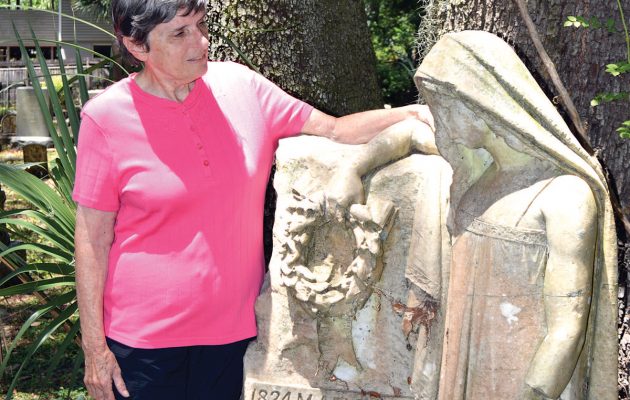Cemetery blog provides rich resource on St. Nicholas history

Although she has no familial connections to anyone buried in the Historic St. Nicholas Cemetery on Olive Street, Kay Ellen Gilmour probably knows more about the people buried beneath its ground than anyone alive. Through her blog, Historic St. Nicholas Cemetery, which she developed a few months ago, Gilmour shares for free what she knows about the old-time burial ground and its history with anyone who is interested.
Gilmour, a retired cardiologist, is the author of A Genealogical History of Florida Revealed in the Historical St. Nicholas Cemetery, which provides a study of the genealogy of the cemetery’s inhabitants, who she calls “Cemeterians,” and their place in the history St. Nicholas, Northern Florida and the United States.
Taking up just under an acre of land, the small graveyard, which is nestled in residential St. Nicholas, was originally part of the Francis Bagley Spanish Land Grant and owned by the Holmes family. The Holmes donated the land to the non-denominational Union Church, which burned some years later and was not rebuilt, Gilmour said. The burial ground originally served pioneer families and later welcomed long-time friends. Ironically, the last person to be interred, William Darius Ferris IV in 2007, was the great-grandson of William Darius Ferris, Sr., the first person who was buried within its walls in 1849.
As a St. Nicholas resident who has lived near the abandoned cemetery since 1971, Gilmour has joined her neighbors over the years in maintaining its grounds. Considering herself the landmark’s “historian,” Gilmour said she wrote her book with the purpose of using all the proceeds from its sale to financially support the burial site.
Gilmour said she became interested in genealogy after her mother’s death in 1999. While cleaning out her mother’s belongings, she discovered a huge chest filed with thousands of family documents and photos dating back to 1819 as well as family letters written during the Civil War and World War I. Included were photos taken by her grandmother, a historical photographer who documented the life and times of the people in her New York community in the early 20th century.
“I’m an only child and I have no children. I asked myself, ‘what do I do with these treasures?’” Gilmour said.
Gilmour set to work scanning the documents and identifying the people in the photographs, a task that took her two years. “At the time I was a busy 24-hour-a-day doctor,” she said.
She also signed up for ancestry.com, a genealogical website, even though she had no clue how to use it to do family research. Not wanting to yet tackle her own family history, Gilmour decided to “experiment” by researching some of the names found on headstones in the historic St. Nicholas cemetery.
“The more I got into it, the more interesting it became,” she said. “The people in the cemetery are the history of our country. They are not just St. Nicholas but Florida and the United States,” she said. “The lives of our Cemeterians reach out to tell their stories to all who will take the time to listen. They tell us how they lived and died to make our place in the world. They ask nothing more of us than our support in maintaining the dignity of their final resting place,” she wrote in the book’s introduction. “I started out to report on the lives of those persons actually buried in our neighborhood cemetery. However, my curiosity got the better of me and I began to research the ancestors of those folks.”
Gilmour said her first book attempt was “skinny.” Even after two more fleshed-out editions, she still considers her book more “informational” than a “work of art.”
“This book has so much information and is written so differently. I don’t know of any other genealogical history of Florida that’s out there,” she said. Organized like a “three-act” play, Gilmour’s book includes sections entitled Intermission, Curtain Call and After Party. Each act covers a different period in St. Nicholas history beginning in 1565 and ending with the Great Fire of 1901.
Also included are essays on pertinent topics such as diseases suffered by the Cemeterians (Gilmour considers herself more doctor than author), their occupations, the naming of Jacksonville, and slavery. Through her research, Gilmour discovered the unusual fact that an African American Civil War veteran lies alongside two white soldiers of the Confederacy.
Three months ago, Gilmour decided to place information from her book on the internet through her blog, hoping to provide an additional resource for people researching family history. So far, in addition to Jacksonville followers, she has gotten many hits from throughout North America, as well as Germany and Russia.
“The blog consists of information from the book as individual posts,” Gilmour explained. “What I am doing is cutting and pasting this book onto the internet to share with people who may have an interest in it for free.”
After researching her family history, Gilmour has also written three historical novels about the Palatines, a group of German immigrants who settled in central New York. She is currently working on a fourth book in the Palatine series.
An avid traveler who has spent time in 134 countries, Gilmour also manages two travel websites – womentravelsafetutorial.com and womentravelsafeblog.com and is working to share online the travel journals of her housemate, Lois Olive Gray.
By Marcia Hodgson
Resident Community News






